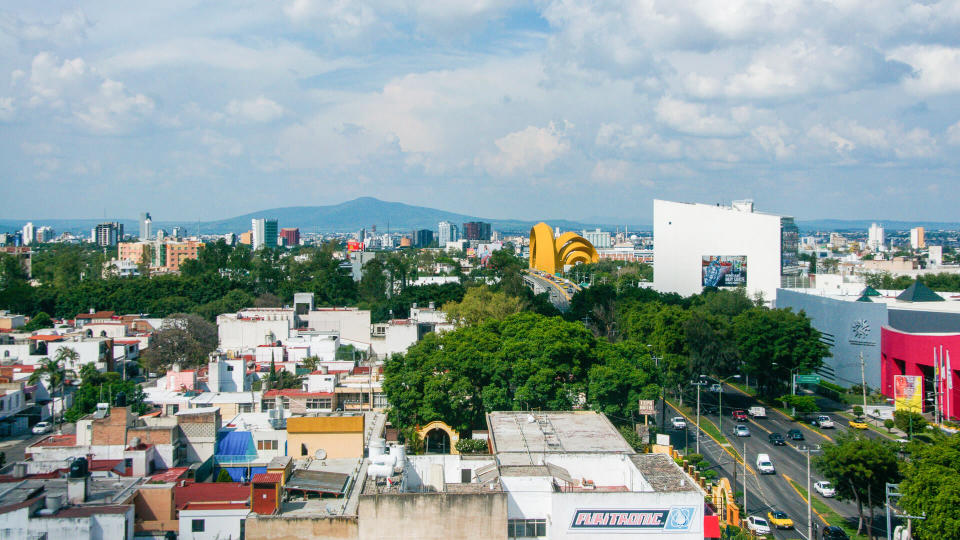I Retired to Mexico: Here’s How Much I Spend in a Month — and What It Cost To Get Here
5 min read
According to International Living, nearly 2 million U.S. citizens have moved to Mexico in pursuit of a better life. Many Americans dream of retiring abroad for the lower cost of living and relaxing lifestyle.
David Bach: Here’s Why You Should Start Collecting Social Security ASAP
Discover: The Simple, Effective Way To Fortify Your Retirement Mix
For retired Arizona couple Ken and Eliza Johnson, that dream became reality when they moved to Mexico’s Lake Chapala region. Now in their late 60s, they find Mexico’s slower pace and affordable lifestyle perfect for this stage of life.
Choosing Where To Retire in Mexico
The Johnsons considered touristy spots like Cabo San Lucas and Puerto Vallarta, but they wanted authentic Mexico. Their research led them to Ajijic, on Lake Chapala’s shores about 45 minutes south of Guadalajara.
Surrounded by mountains with mild, dry weather year-round, the bustling town offered an authentic Mexican experience with a strong expat community.
“We loved Ajijic’s cobblestone streets, colorful adobe houses, excellent restaurants and thriving arts scene,” said Ken.
Renting an apartment in Ajijic for two months, they experienced the friendly culture and seamless transition many retirees enjoy.
“We never felt unsafe or struggled to communicate in English,” Eliza said. “The slower pace just felt right for retirement.”
After decades of raising children and climbing the corporate ladder, Ajijic’s walkable streets and abundance of leisure activities suited their lifestyle goals.
“We’re done with snowy winters and long commutes,” Ken added. “Ajijic gave us the perfect balance to start this new chapter.”
Downsizing for Retirement? Stay Away From These 7 Homes
Estimated Costs To Retire in Mexico
Retiring abroad requires extensive planning and some investment upfront.
According to Mexican Relocation Guide, requirements for temporary residency visas include proof of monthly income from $2,400 to $2,700 over the past six months or a minimum savings or investment account balance of $45,000 per month for the past year.
Temporary visas allow residency for six months up to four years initially. For permanent residency, applicants need proof of $4,300 to $4,500 in monthly income over the past six months or a minimum $180,000 savings balance each month for the past year. Permanent residency does not expire and enables pursuing citizenship.
It’s also possible to obtain a temporary visa through investing $100,000 in a Mexican business. Investing over $200,000 makes applicants eligible for permanent residency and accelerated citizenship.
As far as actual relocation costs, those are estimated at around $7,750-$15,000 — but can be significantly less if you don’t use movers. This covers visas, shipping household goods, temporary housing and basics like a bank account and insurance.
For the Johnsons, total costs to relocate came to around $7,500:
-
$600 for visa applications
-
$3,500 for movers from Arizona to Guadalajara
-
$700 for two one-way flights to Guadalajara on Volaris
-
$1,200 for first month’s rent, basic furnishings and household items
-
$1,500 for a used Nissan Tsuru, fees and car insurance
While not cheap, they saw it as an investment in future happiness and savings.
“We don’t miss all the stuff we left behind,” said Ken. “I know it sounds cliche, but it’s liberating to downsize.”
Monthly Retirement Costs
Numbeo estimates average monthly costs for two in Mexico’s Lake Chapala area around $1,620 plus rent. International Living cites similar expat budgets from $1,500 to $2,500 per month for a couple.
The Johnsons spend about $1,800 monthly:
-
Housing: $500 covers rent and utilities for their two-bedroom apartment. Similar units rent for $400 to $600.
-
Food: $430 for groceries and dining out a few times per month.
-
Transportation: $170 covers gas and maintenance on their used car. This enables exploring beyond Ajijic.
-
Healthcare: $350 for health insurance and medications. Healthcare is a fraction of U.S. costs.
-
Entertainment: $300 for movies, concerts, gym, clubs and travel within Mexico. Excellent free entertainment abounds too, as the Johnsons are always quick to point out.
-
Other expenses: $250 for clothing, personal items, etc. Most purchases cost less than back home.
“Our total costs are around 65% less than our former lifestyle in Arizona,” Eliza estimated. “And healthcare alone is a small fraction compared to U.S. expenses, even with a premium policy. This was a huge, welcome surprise for us.”
The low cost of living allows them to live well in Mexico on Social Security and retirement savings. “We couldn’t stretch our money nearly this far back home,” added Ken.
Buying vs. Renting in Mexico
The Johnsons chose to rent initially to retain flexibility. Long term, buying property in Mexico is an option. They are considering purchasing a two- to three-bedroom home in Ajijic for around $150,000 to $350,000.
“As rents creep up, buying might be a good idea for locking in housing costs,” said Ken.
Mortgages are available to foreigners at rates around 10% down with 9%-12% interest rates, and the monthly mortgage payments often compare to rent.
The buying process in Mexico differs from the U.S. Banks generally will not provide the mortgage until after closing, so buyers must have cash savings ready to transfer at closing. There are also bank trust options that enable using the property as collateral.
Owning a home in Mexico allows the couple to customize their space and potentially generate rental income down the road.
“We’re still exploring the pros and cons of buying versus renting long term,” added Eliza.
Staying Engaged While Retiring Abroad
An active social life and community connections are essential for retirement satisfaction, especially abroad. The Johnsons immersed themselves in local culture by studying Spanish intensively through weekly classes.
Eliza joined the Ajijic Singers choir for regular performances while Ken volunteers at their church to stay engaged.
“Music has always been a big part of my life,” she said. “Now I get to fully immerse myself in my passions.”
Ken plays tennis twice a week with a local group. “It’s a great way to meet people and stay active in retirement.” They also joined a popular walking club for exploring trails and sights together.
Through these pursuits, they formed a diverse social circle with fellow expats and Mexicans.
“It’s a nourishing community — we feel anchored here,” said Eliza.
“Boredom and isolation are non-issues for us,” added Ken.
Staying active and building connections eased their transition and enriched their daily life in Mexico.
More From GOBankingRates
This article originally appeared on GOBankingRates.com: I Retired to Mexico: Here’s How Much I Spend in a Month — and What It Cost To Get Here


